Bell Pozharsky: characteristics, cultivation, reproduction
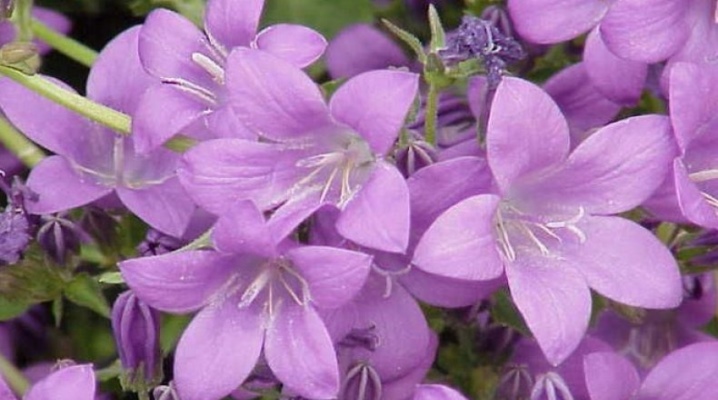
Bellflower is a beautiful plant from the Kolokolchikov family. There are about 300 species in this family. The flower acquired this name due to the shape of the inflorescence, similar to the bell. In the wild, it grows like a perennial, but there are also annual species. There are many types of bells with a variety of colors. The plant is widespread among gardeners due to its scenic qualities.
Pozharsky's bell is a popular species. The plant is named after the German botanist Gustav Pozharsky, who worked in the Dresden Botanical Garden. Campanula has mountain roots, its homeland is the north of the Balkan Peninsula. This plant can be found in the mountains of Montenegro and Croatia. The main variety of its varieties is found in Eastern and Western Europe.
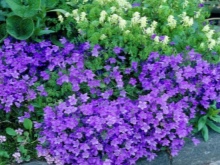
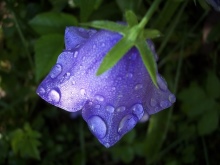

Description
Campanula, or Pozharsky's bell, is a perennial plant that reaches a height of 20 cm, can grow in width and spread its shoots up to half a meter. Campanula's small green leaves are round in shape with jagged edges. The leaves located at the root of the plant are medium in size, and those that are closer to the top are smaller in size. At the end of the stems, there are 25 mm bell-shaped inflorescences. Their colors can be very diverse: blue, pink, blue, purple.
Flowering begins in July and lasts until the end of August. Flowers exude a pleasant aroma. After the end of flowering, a fruit with seeds is formed on the inflorescence. The bell is unpretentious in care, it is quite adapted to drought and winter cold. It does not require additional shelter for the winter. Grows well both in the shade and in the sun.
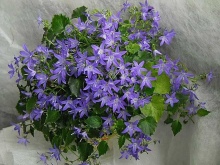

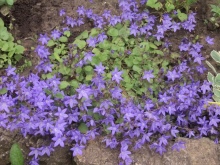
Varieties
This species has many bred combs, which differ in their colors and size of flowers. Consider the most popular varieties.
- Silberregen - one of the most popular varieties among gardeners. Differs in abundant flowering, which begins in May and ends in September. Flowers of snow-white color on a green background of leaves resemble a snow globe. The most frost-resistant, durable and hardy variety among its fellows.
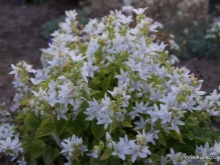
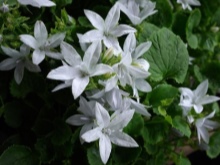
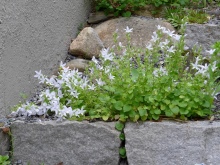
- Blue gown - the variety is ideal for ampelous planting. Forms loose bushes with heart-oval leaves and a sharp edge. Shoots are short. They form from 3 to 5 blue bells with a white center inside. Flowering begins in June and lasts until September. The variety loves sandy-clay soils with an admixture of lime. Grows in shade or partial shade. Propagated only by dividing the bush or cuttings. Looks great in hanging pots or tall urns.
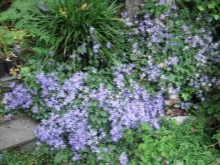
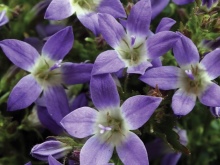

- Blue waterfall - a low (up to 20 cm in height) plant can grow on the ground up to 80 cm. It blooms from May to June in a gorgeous lilac color. Re-flowering is possible in September. A frost-resistant variety, perfectly suited for decorating rocky slopes and alpine hills. Prefers to grow in light soil.
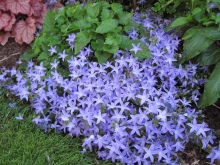
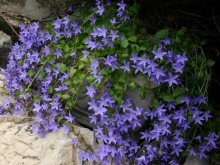
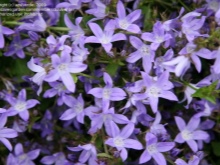
- E. H. Frost - cushion perennial, capable of spreading on the ground up to 80 cm wide. Used as a ground cover plant, blooming from June to July with incredible white flowers that resemble a volumetric foam. After trimming the faded inflorescences, wait for the re-flowering. Drought-resistant variety, does not tolerate stagnant water and acidic soils. Looks great in a group planting with scarlet carnations or poppies.

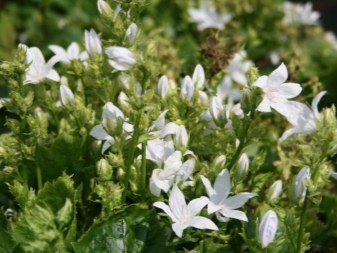
- Lisduggan Variety - a herbaceous ground cover plant reaches a maximum height of 15-20 cm. The growth width is possible up to 80 cm. A beautiful, abundant flowering of a light pink or purple hue begins in July and lasts until August. After flowering, seed boxes ripen. It has small, oval leaves with jagged edges. Loves partial shade and drained, slightly alkaline soil. Needs moderate watering without moisture stagnation. It is recommended to cover the plant for the winter. Gardeners grow this variety mainly in pots, but it is also possible to decorate curbs, rocky soil.
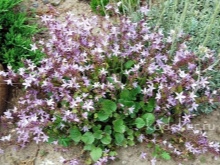
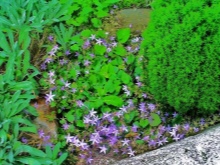

- Stella - reaches a height of 20 cm. Long shoots spread on the ground 80 cm wide. The flowers are blue or pink, 2.5 cm in diameter. Flowering begins in early July and lasts until September. This variety does not tolerate shade, grows only in the sun in well-drained, non-acidic soil. Prefers moderate watering. Suitable for pot planting or rocky gardens.
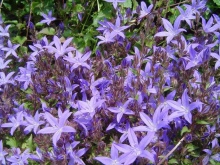
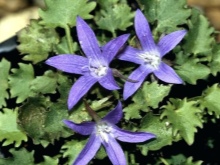

- Grandiflora alba - a popular variety of its kind. Differs in a unique flower shape. They seem to be airy, light; located on a shoot 70 cm high. In good conditions, the plant can reach a height of 1 meter. Leaves are green, linear, carved at the edges. The flowers are snow-white, large, up to 5 cm in diameter. They are pulled up into a racemose inflorescence, drooping downward. The bell blooms all summer, from June to August. Prefers a sunny location with little shade. The soil should be sandy or sandy loam.
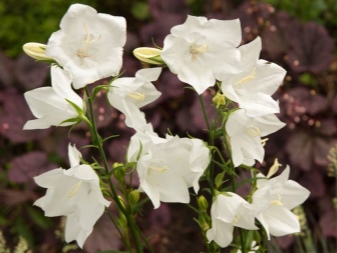
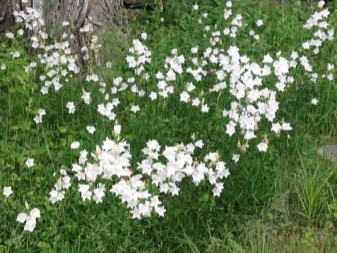
Planting and leaving
It is necessary to plant the bell in the spring. Prepare a shaded area for growing. It is desirable at a low elevation so that there is no stagnation of water. In the shade, the plant will not bloom densely, and the leaves will stretch upward. Also, there should be no drafts or prerequisites for strong gusts of wind.
Dig up the soil first and remove the weeds. Open ground should be well-drained, lightweight and neutral. Place the seedlings in a small depression in the ground, water well. The distance between them should be about 15 cm.
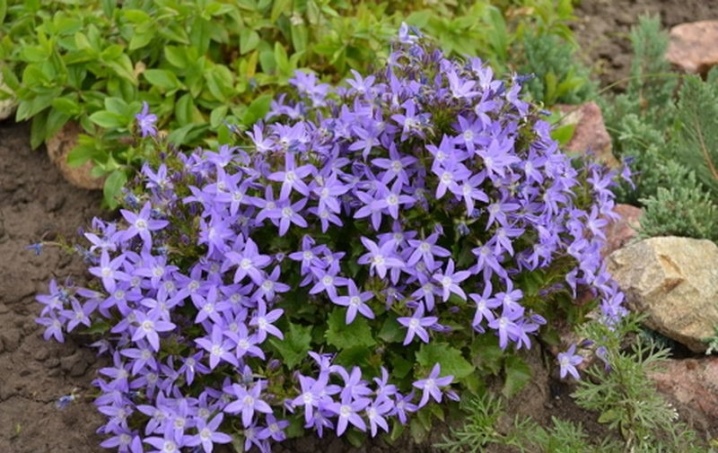
Caring for a bell is pretty straightforward. Watering should be moderate as the soil dries up. With an excess of moisture at the root, the roots may freeze in winter. For abundant flowering, it is necessary to remove faded inflorescences. This stimulation contributes to the constant renewal of inflorescences.
During intensive flowering in the spring, it is necessary to make top dressing in the form of wood ash. Do not mulch the soil near where the root is to avoid accidentally damaging it. During the period when buds begin to form, apply fertilizing in the form of mineral fertilizers. Since the plant is not tall, weeds can "clog" it, so weeding the land is simply necessary.
Certain varieties can be grown in pots or hanging vases. Caring for them is the same as for a plant in the open field.

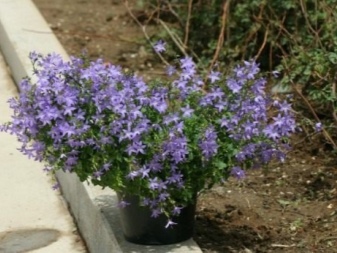
Disease and pest control
Pozharsky's bell is distinguished by good immunity, but despite this, under adverse weather conditions or improper care, it can be affected by pests and fungal diseases. The most common parasites are slugs and leafhoppers. They feed on the sap of the plant. The result of this action is that the leaves wrinkle, small holes appear on them, the buds do not ripen and begin to fall off.
As a preventive measure, do not allow thickening of the plantings. To combat, use spraying with a decoction of wormwood or tobacco. For better adhesion of the composition to the plant, add a soap solution. From chemicals you can use "Kinmiks" or "Aktara".
Intense humidity can cause rot. It affects the root system, the plant begins to become covered with a gray bloom, and the roots rot. The appearance of rust is indicated by yellow spots on the leaves, which then begin to dry and fall off.For the treatment of this disease, preparations are used with an admixture of sulfur or Bordeaux liquid with other fungicides.
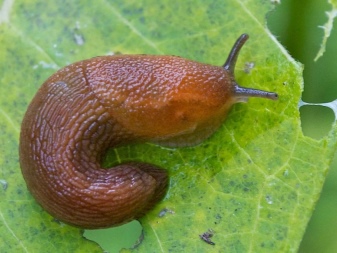
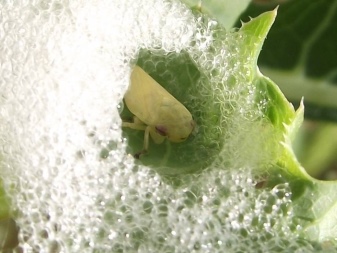
Reproduction
The most common breeding method for Pozharsky's bell is seed. In autumn, seeds are harvested from ripe dry inflorescences. The seed is separated from the capsules and prepared for planting. To do this, a little sand should be added to the seeds, this will facilitate sowing, since the seeds are very small, like dust.
It is recommended to plant them in March. To do this, take a container with light and nutritious soil. Seeds are scattered on the surface without pressing into the soil, sprayed from a spray bottle to moisten and covered with film or glass for a greenhouse effect.
The capacity should be determined in a bright, warm place. After 10 days, the first shoots will appear, which must be watered moderately. When leaves appear, seedlings can be dived and transplanted into a larger container. The distance between the shoots should be 10 cm apart. They must be loosened and sprayed regularly. After 2 weeks, you can feed the soil with a low concentration of fertilizer. In May, the seedlings are ready for planting in open ground.

Pozharsky's bell is a great decor for any garden, flower bed or pot. Unpretentious to care for, he can get along on a site with any plantings. A variety of colors will please any gardener. Proper care of the plant will give you long-term beautiful bloom for the whole summer.
How to sow bell seeds for seedlings correctly, see the video.







































































































The comment was sent successfully.